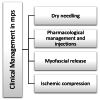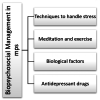A Biopsychosocial Model-Based Clinical Approach in Myofascial Pain Syndrome: A Narrative Review
- PMID: 33936911
- PMCID: PMC8081263
- DOI: 10.7759/cureus.14737
A Biopsychosocial Model-Based Clinical Approach in Myofascial Pain Syndrome: A Narrative Review
Abstract
One of the most common chronic musculoskeletal pain syndromes is myofascial pain syndrome (MPS). Trigger points (TrPs) are hypersensitive taut bands that appear in two genres, each with a different ratio in specific areas of the muscles, and when triggered, they can produce pain, numbness, and tingling. Various underlying causes (mechanical, nutritional, and psychological) have been discovered to participate in the pathogenesis of MPS, activating trigger points and intensifying the pain. Furthermore, genetic, social, and psychological factors seem to exacerbate these patients' clinical appearance, according to the biopsychosocial model, which seems to be closely linked to the formation of trigger points. Chronic pain and psychological distress frequently coexist, and psychological and social factors have been found to worsen the patient's quality of life and perpetuate the existing pain. The diagnosis is formed following a comprehensive physical and clinical examination, and the appropriate management technique is selected. For MPS treatment, management techniques based on the biopsychosocial model are used in conjunction with various myofascial release strategies and pharmacologic care. Exercise, posture correction, and a vitamin balance in the diet, especially in the Vitamin B complex, appear to prevent trigger point (TrP) activation. The precise etiology of MPS is not clear yet, and further research is needed to determine the root cause. A holistic approach, which blends the basic clinical care with the management of the biopsychosocial model, is essential to patients with MPS to regain their function and improve their quality of life and wellbeing.
Keywords: biopsychosocial model; myofascial pain syndrome; pain management; treatment; trigger points.
Copyright © 2021, Koukoulithras et al.
Conflict of interest statement
The authors have declared that no competing interests exist.
Figures
References
-
- Iasp terminology. [Dec;2017 ];https://www.iasp-pain.org/Education/Content.aspx?ItemNumber=1698#Pain 2017
-
- Fibromyalgia and myofascial pain syndrome-a dilemma. Chandola HC, Chakraborty A. https://www.ijaweb.org/text.asp?2009/53/5/575/60336. Indian J Anaesth. 2009;53:575–581. - PMC - PubMed
-
- Myofascial pain syndrome associated with trigger points: a literature review (I): epidemiology, clinical treatment and etiopathogeny. Delgado EV, Romero JC, Escoda CJ. Med Oral Patol Oral Cir Bucal. 2009;14:0–8. - PubMed
-
- Clinical biopsychosocial physiotherapy assessment of patients with chronic pain: the first step in pain neuroscience education. Wijma AJ, van Wilgen CP, Meeus M, Nijs J. Physiother Theory Pract. 2016;32:368–384. - PubMed
Publication types
LinkOut - more resources
Full Text Sources
Other Literature Sources





